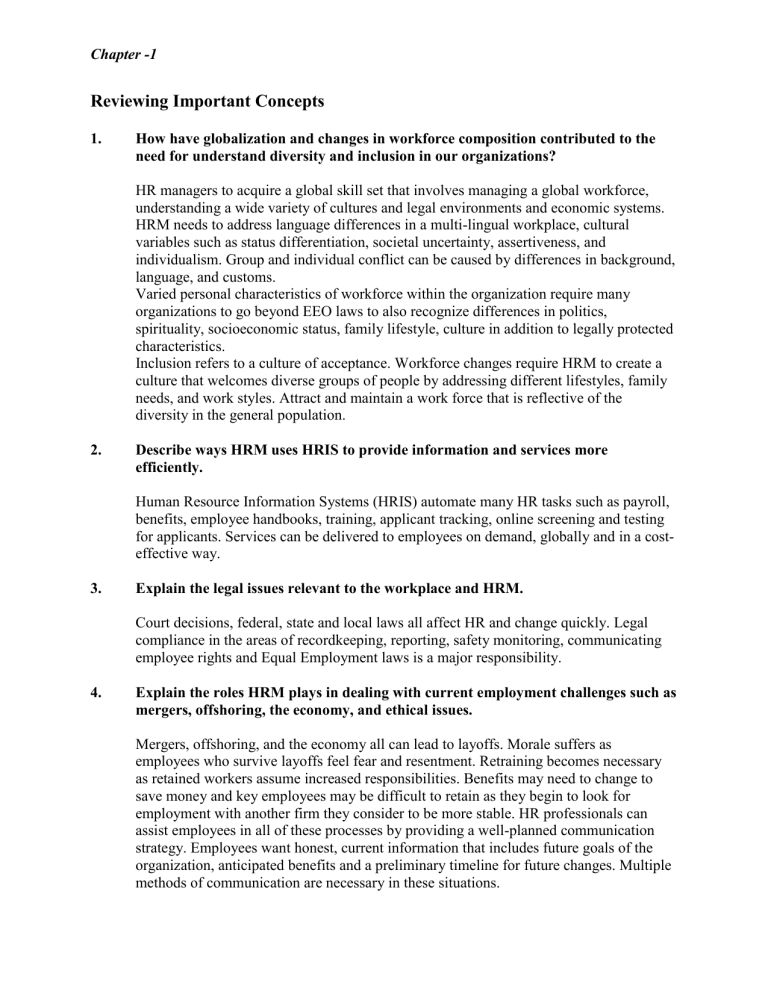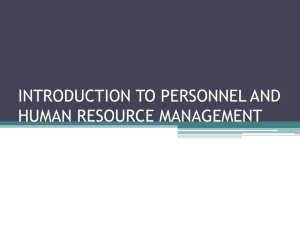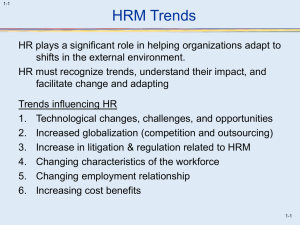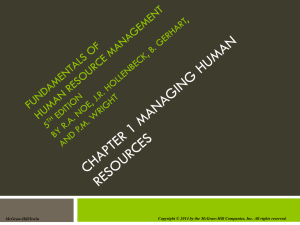
Chapter -1 Reviewing Important Concepts 1. How have globalization and changes in workforce composition contributed to the need for understand diversity and inclusion in our organizations? HR managers to acquire a global skill set that involves managing a global workforce, understanding a wide variety of cultures and legal environments and economic systems. HRM needs to address language differences in a multi-lingual workplace, cultural variables such as status differentiation, societal uncertainty, assertiveness, and individualism. Group and individual conflict can be caused by differences in background, language, and customs. Varied personal characteristics of workforce within the organization require many organizations to go beyond EEO laws to also recognize differences in politics, spirituality, socioeconomic status, family lifestyle, culture in addition to legally protected characteristics. Inclusion refers to a culture of acceptance. Workforce changes require HRM to create a culture that welcomes diverse groups of people by addressing different lifestyles, family needs, and work styles. Attract and maintain a work force that is reflective of the diversity in the general population. 2. Describe ways HRM uses HRIS to provide information and services more efficiently. Human Resource Information Systems (HRIS) automate many HR tasks such as payroll, benefits, employee handbooks, training, applicant tracking, online screening and testing for applicants. Services can be delivered to employees on demand, globally and in a costeffective way. 3. Explain the legal issues relevant to the workplace and HRM. Court decisions, federal, state and local laws all affect HR and change quickly. Legal compliance in the areas of recordkeeping, reporting, safety monitoring, communicating employee rights and Equal Employment laws is a major responsibility. 4. Explain the roles HRM plays in dealing with current employment challenges such as mergers, offshoring, the economy, and ethical issues. Mergers, offshoring, and the economy all can lead to layoffs. Morale suffers as employees who survive layoffs feel fear and resentment. Retraining becomes necessary as retained workers assume increased responsibilities. Benefits may need to change to save money and key employees may be difficult to retain as they begin to look for employment with another firm they consider to be more stable. HR professionals can assist employees in all of these processes by providing a well-planned communication strategy. Employees want honest, current information that includes future goals of the organization, anticipated benefits and a preliminary timeline for future changes. Multiple methods of communication are necessary in these situations. Chapter -1 5. What is the purpose of a continuous improvement program? What role does HRM play in assisting continuing improvements? Continuous improvement involves constant efforts to provide better products and service to customers, with today’s definition of customer including everyone both external and internal to the organization. HRM assists by helping employees cope with the emotional aspects of conflict and change, providing skills training and adapting HR systems, such as compensation, benefits, and performance standards. 6. What are the necessary ingredients for a successful employee involvement program? Organizational culture and top management must support involvement. Employees at all levels will need to delegate some of their activities and responsibilities. Involving employees on work teams. Emphasis on participative management using group decision making. HRM must provide training to help empower employees in their new roles. 7. Explain what ethics are and how organizations and HRM can promote ethical behavior. Ethics is a set of rules or principles that defines right and wrong conduct, what is considered "right” and “wrong” in the organization. HRM can establish ethics training and a code of ethics that states an organization’s values and the ethical rules it expects organizational members to follow.



